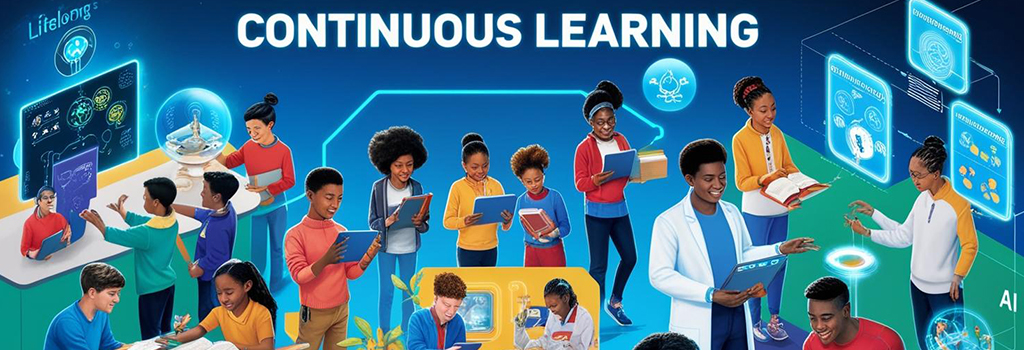
April 1, 2025
In today’s fast-evolving world, continuous learning isn’t just a buzzword—it’s a lifeline for educators and students alike. For educators, fostering a culture of lifelong learning is key to preparing students for an unpredictable future. As highlighted in Zamit’s blog, “Creating a Continuous Learning Culture in Schools”, “schools must evolve into ecosystems where learning is dynamic, ongoing, and integrated into everyday life.” This vision is already taking root globally, with inspiring success stories showcasing how continuous learning drives success. Let’s explore some real-world examples, including from India, and see how they illuminate the path forward.
Continuous learning equips educators to stay ahead of change, ensuring students gain the importance of 21st-century skills for students—like critical thinking, collaboration, and adaptability. A standout example comes from Finland, often hailed as an education pioneer. Finnish teachers engage in mandatory professional development throughout their careers, averaging 5-10 days annually. This isn’t a checkbox exercise; it’s a deep dive into innovative pedagogies and emerging tech, like AI-driven tools. The result? Finnish students consistently excel in global assessments like PISA, not just in academics but in problem-solving and creativity—skills vital for the 21st century.
Closer to home, India offers its own compelling story. The Kerala Education Model demonstrates how continuous learning transforms communities. Teachers in Kerala participate in regular in-service training through initiatives like the District Institutes of Education and Training (DIET). A 2020 study by the National Council of Educational Research and Training (NCERT) found that these programs improved teacher competency by 30%, directly boosting student literacy rates to over 95%—one of India’s highest. By embracing ongoing learning, Kerala’s educators show how to develop future-ready students who can navigate a shifting job market.
Students, too, thrive when continuous learning becomes part of their DNA. Zamit’s blog, “Continuous Learning: The key to Lifelong Success”, notes, “Students who adopt a mindset of lifelong learning are better equipped to face future challenges with resilience and innovation.” Take Malala Yousafzai’s story as a global benchmark. After surviving an attack for advocating girls’ education in Pakistan, Malala pursued learning relentlessly, earning a degree from Oxford University in 2020. Her journey underscores the importance of 21st-century skills for students, such as perseverance and advocacy, which she now channels through the Malala Fund to educate millions.
In India, the Super 30 program in Bihar offers a homegrown triumph. Founded by Anand Kumar, this initiative trains underprivileged students for the IIT entrance exams, emphasising continuous self-study beyond traditional classrooms. Since 2002, over 400 students from Super 30 have cracked the IIT-JEE, with many from families earning less than $100 annually. Kumar’s approach—daily problem-solving sessions and peer mentoring—illustrates how to develop future-ready students by fostering grit and analytical thinking, key 21st-century skills that defy socio-economic barriers.
Educators who model continuous learning inspire their students to follow suit. In the United States, the National Board Certification process exemplifies this. Teachers like Sarah Brown Wessling, named the 2010 National Teacher of the Year, pursued this rigorous certification to refine her craft. The process involves self-assessment, peer reviews, and classroom video analysis—mirroring the benefits of holistic education assessment. Wessling credits this journey with sharpening her ability to teach critical thinking, a skill she passes on to her Iowa students, preparing them for complex futures.
India’s Teach For India (TFI) fellowship offers a parallel narrative. Since 2009, TFI has recruited young leaders to teach in underserved schools, requiring them to engage in continuous professional development. Fellows like Shaheen Mistri, TFI’s founder, emphasise learning from community feedback and adapting to student needs. A 2022 TFI impact report showed that 85% of their students improved in literacy and numeracy, thanks to fellows’ focus on developing future-ready students through innovative, student-cantered methods. This reflects the benefits of holistic education assessment, as TFI evaluates both academic growth and emotional resilience.
Technology amplifies continuous learning, and India is seizing this opportunity. The DIKSHA platform, launched by the Ministry of Education in 2017, provides free digital resources for teachers and students. With over 80,000 pieces of content, including videos and quizzes, DIKSHA supports ongoing learning in 18 languages. A 2023 UNESCO report noted that teachers using DIKSHA improved lesson delivery by 25%, enhancing student engagement in rural areas. This digital ecosystem aligns with Zamit’s vision of integrating tech into learning, highlighting the importance of 21st-century skills for students like digital literacy and collaboration.
These success stories aren’t without hurdles. Time, funding, and access remain barriers. Finnish teachers benefit from government support, while Kerala’s model relies on state funding—luxuries not universal in India. Super 30 operates on donations, and TFI fellows often face resource shortages. Yet, these examples prove that commitment to continuous learning can overcome constraints. Educators can start small—joining online communities, like Zamit’s teacher networks, or leveraging free tools like DIKSHA—to build momentum.
So, how can you bring continuous learning to life? First, embrace professional development. Platforms like Coursera or India’s SWAYAM offer courses on how to develop future-ready students through tech and pedagogy. Second, foster a classroom culture where mistakes are learning opportunities, encouraging 21st-century skills like creativity. Third, use tools like Zamit’s ZQ assessments to tap into the benefits of holistic education assessment, tracking not just grades but skills and resilience.
These stories—Finland’s teachers, Kerala’s educators, Super 30’s students, TFI’s fellows, Zamit teachers —show continuous learning in action. They’re not just success tales; they’re blueprints. As educators, you’re the architects of this future. Start today: explore a new resource, connect with a peer, or rethink your assessment approach. The ripple effect will prepare your students—and yourself—for a world that never stops evolving.